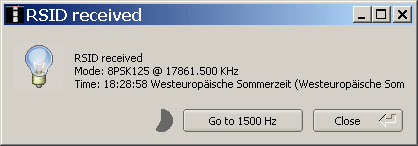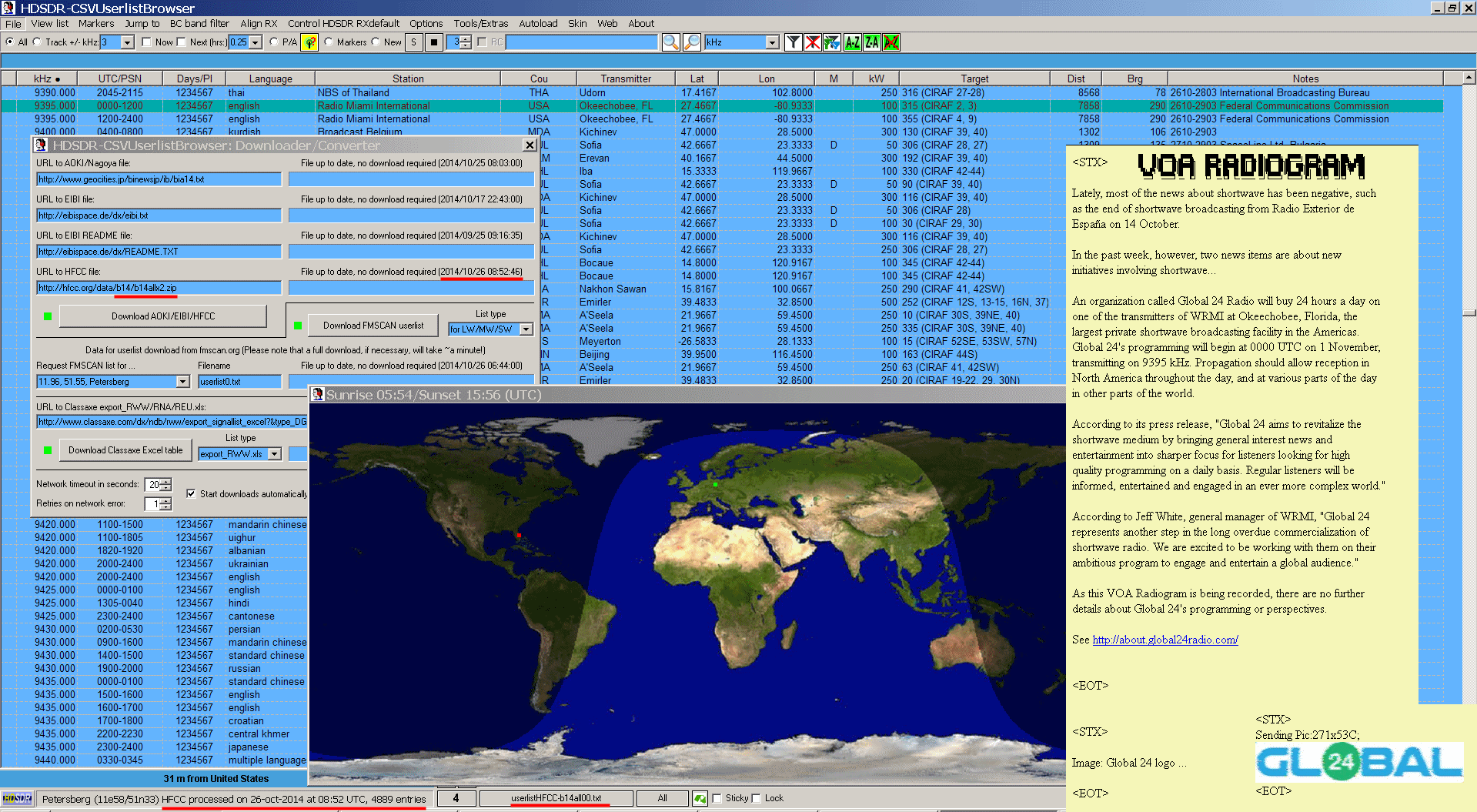
www.rhci-online.net/radiogram/radiogram.htm
██╗ ██╗██████╗ ██████╗ ██████╗ █████╗ ██████╗ ██╗ ██████╗ ██████╗ ██████╗ █████╗ ███╗ ███╗ ██║ ██╔╝██╔══██╗██╔════╝ ██╔══██╗██╔══██╗██╔══██╗██║██╔═══██╗██╔════╝ ██╔══██╗██╔══██╗████╗ ████║ █████╔╝ ██████╔╝██║ ██████╔╝███████║██║ ██║██║██║ ██║██║ ███╗██████╔╝███████║██╔████╔██║ ██╔═██╗ ██╔══██╗██║ ██╔══██╗██╔══██║██║ ██║██║██║ ██║██║ ██║██╔══██╗██╔══██║██║╚██╔╝██║ ██║ ██╗██████╔╝╚██████╗ ██║ ██║██║ ██║██████╔╝██║╚██████╔╝╚██████╔╝██║ ██║██║ ██║██║ ╚═╝ ██║ ╚═╝ ╚═╝╚═════╝ ╚═════╝ ╚═╝ ╚═╝╚═╝ ╚═╝╚═════╝ ╚═╝ ╚═════╝ ╚═════╝ ╚═╝ ╚═╝╚═╝ ╚═╝╚═╝ ╚═╝
|
RSID: <<2014-10-25T11:31Z
MFSK-64
@ 6095000+1500>>
<STX>
Some recent news about shortwave, also know as "high frequency"
...
"The [U.S] Department of Veterans Affairs plans to build a
nationwide high-frequency radio network to connect its medical
facilities in case of an emergency that knocks out other forms of
communications — applying century-old technology to current
needs. ...
"The network will include an undefined number of high-powered
'backbone' stations equipped with 200-watt transmitters designed
to receive and automatically relay communications from 125-watt
stations located at approximately 200 Veterans Health
Administration facilities, VA said."
Full text: http://bit.ly/1CU31CD
====>
http://www.defenseone.com/technology/2014/10/preparing-future-catastrophes-va-reaches-past/96824/
<EOT>
<STX>
Sending Pic:122x80;

<EOT>
<STX>
Thanks to The Mighty KBC.
<EOT>
██╗ ██╗ ██████╗ █████╗ ██████╗ █████╗ ██████╗ ██╗ ██████╗ ██████╗ ██████╗ █████╗ ███╗ ███╗ ██║ ██║██╔═══██╗██╔══██╗ ██╔══██╗██╔══██╗██╔══██╗██║██╔═══██╗██╔════╝ ██╔══██╗██╔══██╗████╗ ████║ ██║ ██║██║ ██║███████║ ██████╔╝███████║██║ ██║██║██║ ██║██║ ███╗██████╔╝███████║██╔████╔██║ ╚██╗ ██╔╝██║ ██║██╔══██║ ██╔══██╗██╔══██║██║ ██║██║██║ ██║██║ ██║██╔══██╗██╔══██║██║╚██╔╝██║ ╚████╔╝ ╚██████╔╝██║ ██║ ██║ ██║██║ ██║██████╔╝██║╚██████╔╝╚██████╔╝██║ ██║██║ ██║██║ ╚═╝ ██║ ╚═══╝ ╚═════╝ ╚═╝ ╚═╝ ╚═╝ ╚═╝╚═╝ ╚═╝╚═════╝ ╚═╝ ╚═════╝ ╚═════╝ ╚═╝ ╚═╝╚═╝ ╚═╝╚═╝ ╚═╝
RSID: <<2014-10-25T16:01Z
MFSK-32 @ 17860000+1500>>
Welcome to program 82 of VOA Radiogram from the Voice of America.
I'm Kim Andrew Elliott in Washington.
Here is the lineup for today's program (all MFSK32 except for the
surprise mode):
1:31 Program preview (now)
2:34 New shortwave initiatives, with images
8:29 New network sharing system
12:28 Ocean microbes eat methane, with image
20:05 Morocco solar power plant, with image
25:53 Closing announcements, with MFSK64 logo
28:29 Surprise mode of the week (requires Fldigi 3.22)
Please send reception reports to radiogram@voanews.com.
And visit voaradiogram.net.
Twitter: @VOARadiogram.net
<EOT>
<STX>
Lately, most of the news about shortwave has been negative, such
as the end of shortwave broadcasting from Radio Exterior de
España on 14 October.
In the past week, however, two news items are about new
initiatives involving shortwave...
An organization called Global 24 Radio will buy 24 hours a day on
one of the transmitters of WRMI at Okeechobee, Florida, the
largest private shortwave broadcasting facility in the Americas.
Global 24's programming will begin at 0000 UTC on 1 November,
transmitting on 9395 kHz. Propagation should allow reception in
North America throughout the day, and at various parts of the day
in other parts of the world.
According to its press release, "Global 24 aims to revitalize the
shortwave medium by bringing general interest news and
entertainment into sharper focus for listeners looking for high
quality programming on a daily basis. Regular listeners will be
informed, entertained and engaged in an ever more complex world."
According to Jeff White, general manager of WRMI, "Global 24
represents another step in the long overdue commercialization of
shortwave radio. We are excited to be working with them on their
ambitious program to engage and entertain a global audience."
As this VOA Radiogram is being recorded, there are no further
details about Global 24's programming or perspectives.
See http://about.global24radio.com/
<EOT>
<STX>
Image: Global 24 logo ...
<EOT>
<STX>
Sending Pic:271x53C;

<EOT>
From shortwave broadcasting to shortwave communications: The
following excerpt from Nextgov never uses the word "shortwave,"
but "high-frequency" (HF) is basically the same as shortwave ...
VA Plans to Build Nationwide High-Frequency Radio Network to
Communicate During Emergencies
By Bob Brewin
October 16, 2014
"The [U.S.] Department of Veterans Affairs plans to build a
nationwide high-frequency radio network to connect its medical
facilities in case of an emergency that knocks out other forms of
communications - applying century-old technology to current
needs. ...
"The network will include an undefined number of high-powered
[sic] "backbone" stations equipped with 200-watt transmitters
designed to receive and automatically relay communications from
125-watt stations located at approximately 200 Veterans Health
Administration facilities, VA said.
"The network would provide emergency two-way radio communication
and links to national wired, cellular and IP telephone networks
enabling radio-to-telephone communications, according to the
agency."
Full text:
http://www.nextgov.com/defense/2014/10/va-plans-build-nationwide-high-frequency-radio-network-communicate-during-emergencies/96644/
<EOT>
<STX>
Image: Veterans Administration logo ...
<EOT>
<STX>
Sending Pic:202x132;

<EOT>
<STX>
This is VOA Radiogram from the Voice of America.
Please send reception reports to radiogram@voanews.com.
VOA NEWS
Network-Sharing System Improves Internet, Cell Phone Connections
George Putic, KI4FNF
October 20, 2014
During major emergencies, like the Boston Marathon bombing in
2010, cell phone and Wi-Fi networks quickly get overloaded. A
group of scientists at the Stevens Institute of Technology in
Hoboken, New Jersey, have designed and successfully tested a
system that automatically uses all available networks, switching
seamlessly from one to another, thus reducing the burden on all
of them.
Modern cell phones have the ability to communicate in various
ways, says professor Suba Subbalakshmi.
"We have several different networks enabled within a cell phone
for example," said Subbalakshmi. "So we can do Wi-Fi, we can do
LTE and so on, but usually it is only one or the other of these
networks that is used at any given time."
With support from the National Science Foundation and National
Institute of Justice, Subbalakshmi, and fellow professor
Rajarathnam Chandramouli, designed a smart wireless router called
SpiderRadio that simultaneously uses parts of both networks,
reducing the burden on them.
"It has multiple radios in it and it can access multiples of
these networks at the same time, and constantly what the router
is doing it is taking measurements," said Chandramouli. "It is
trying to find out what is the quality of the Wi-Fi network in
this location, or Wi-Fi networks in this location, what is the
quality of LTE network, 3G network and so on and so forth, public
safety network and so on."
Graduate student Vidya Sagar, who developed the technical side
and algorithms for SpiderRadio, says communicating via different
networks also improves security.
"It is not so easy to actually track down or sniff your password
because someone who wants to do that should control all wireless
links, which is really difficult," said Sagar.
SpiderRadio has been tested by Idaho National Laboratory. It is
now being used by the police department in Brookline,
Massachusetts as well as in South Africa, where it serves as a
communication hub in a school in Pretoria.
Its creators say eventually the smart router's capabilities will
be transferred to an app that could be installed in any modern
cell phone, enabling it to automatically switch between different
networks.
http://www.voanews.com/content/network-sharing-improves-internet-cellphone-connections-/2490199.html
See also:
http://www.stevens.edu/ses/spider-radio
<EOT>
RSID: <<2014-10-25T16:12Z
MFSK-32 @ 17860000+1500>>
<STX>
This is VOA Radiogram from the Voice of America.
Please send reception reports to radiogram@voanews.com.
VOA NEWS
Microbes in Deep Sea Rocks Eat Global Warming Gas
Rosanne Skirble
October 16, 2014
A new study finds that tiny microbes inside rocks in the deep
ocean are munching on methane.
Methane is a powerful greenhouse gas. Although it doesn't remain
in the atmosphere as long as carbon dioxide, while it's there, it
is more than 80 times more potent than CO2. Methane is emitted by
natural sources such as wetlands, as a byproduct of raising
livestock, as well as from human activities, such as leakage from
natural gas systems. It also is abundant in the ocean - largely
in frozen reservoirs, but also seeping from deep within the
earth's interior, through cracks in the ocean floor.
Little of that gas reaches the atmosphere, thanks to
methane-eating microbes that live in seabed sediments near
methane vents in the deep ocean.
Methane seeps from deep water vents
California Institute of Technology geo-biologist Victoria Orphan
studies the habits of those microbes. She said they are adapted
to survive in this extreme environment.
"These organisms would be able to extract energy from methane
using sulfate found in sea water rather than oxygen and as an end
product would produce hydrogen sulfide. So this is sort of that
rotten egg smell. And also, as another by-product, these
organisms would produce carbonate, sort of like the pavement you
see on the sidewalk," she said.
Over time, that calcium carbonate forms towering rocky seamounts
adjacent to the methane seeps. Orphan hypothesized that those
outcroppings also harbored life, so she hitched a ride on a
submersible down 800 meters to the sea floor to prove it.
Rocks show signs of life
During four expeditions, between 2006 and 2011, samples of the
sediment and the seamounts were retrieved from the near-freezing
water. Orphan said the rock samples confirmed her theory.
"These are not just simply end products of methane oxidation, but
they actually maintain a viable community of microorganisms
living inside the pore spaces of the rock that turns out are
still capable of consuming methane," she said.
Her analysis showed that the seamount microbes did so at a slower
rate than their methane-munching cousins in the sediment,
however, because not as much methane seeps through the tiny
fissures in the rock.
"But, considering that the volume of rock that is available to
colonize down in these deep-sea environments, it still can be a
significant potential source of methane consumption," said
Orphan. "So instead of just considering this just a process that
is going on in sediments, we have this whole other expansive
habitat to look at as a sink for methane over time."
Deep-sea microbes keep methane from escaping ocean
Writing in the journal Nature Communications, Orphan says the
abundance of these tiny organisms - both in sediment and in rock
- explains how the microbes can put a lid on methane in the
world's oceans so it doesn't make it through the water column to
the atmosphere. And, she adds, the diversity of worms, crabs and
other creatures crawling around the rocks consuming the microbes,
may indicate a dynamic - previously unknown - ecosystem.
http://www.voanews.com/content/microbes-in-deep-sea-rocks-eat-global-warming-gas/2486497.html
<EOT>
<STX>
Image: Microscopic image of a group of multi-celled
methane-oxidizing microbes found in deep-sea methane seeps in
Hydrate Ridge, Oregon ...
<EOT>
<STX>
Sending Pic:209x194C;

<EOT>
<STX>
This is VOA Radiogram from the Voice of America.
Please send reception reports to radiogram@voanews.com.
VOA NEWS
Morocco's First Solar Power Plant to Start Operating in 2015
Zlatica Hoke
October 21, 2014
Morocco gets more than a half of its energy from coal. But as
North African kingdom's energy requirements grow, the government
is encouraging Moroccans to look for cleaner sources of energy.
"We need to find alternative forms of energy to meet Morocco's
needs, and the best is solar," Mustapha Bakkourt, of Morocco's
Solar Energy Agency, said. "It's free energy that is unlimited,
available and abundant in Morocco."
As the nation strives to become a world-class renewable energy
producer, its first solar power plant is being constructed near
the desert gateway city of Ouarzazate. Slated to come online in
2015, the Nour 1 thermo-solar plant is the first of five that
Moroccan officials plan to build by the end of the decade.
"Ouarzazate is an environmentally sustainable city with energy,
recycling, land reclamation and water saving," said Hakima
el-Haite, Minister of Energy, Mines, Water and the Environment.
"It's also about micro-irrigation, wastewater reuse, lighting
with solar. It's a smart city."
The $770 million project is expected to have the capacity to
generate 160 megawatts.
The World Bank, the African Development Bank and the European
Investment Bank are helping to finance the Saudi-built solar
complex built, which officials are calling the largest of its
kind in the world.
To raise awareness about Morocco's strong solar-energy potential,
the oil-scarce recently country organized its first international
solar festival.
"We organized this festival to show one idea: gold is in the
sky," said Mehdi Alaoui M'Daghri, an event planner. "The sun is a
treasure for our country. We want to demonstrate this through
three main areas: arts and culture, science and technology,
knowledge and discovery."
Morocco expects to build five new solar plants by 2020 with a
combined production capacity of 2,000 megawatts at an estimated
cost of $9 billion. Officials are hoping to produce enough clean
energy to export some of it to nearby Europe.
http://www.voanews.com/content/morocco-first-solar-power-plant-to-start-operating-in-2015/2490557.html
<EOT>
<STX>
Image: Screen capture from the video version of this VOA News
story ...
<EOT>
<STX>
Sending Pic:265x139C;

<EOT>
<STX>
Please send reception reports to radiogram@voanews.com.
And visit voaradiogram.net.
Twitter: @VOARadiogram
Thanks to colleagues at the Edward R. Murrow shortwave
transmitting station in North Carolina.
I'm Kim Elliott. Please join us for the next VOA Radiogram
This is VOA, the Voice of America.
<EOT>
RSID: <<2014-10-25T16:27Z MFSK-64 @ 17860000+1500>>
<STX>
Sending Pic:506x45C;
![]()
<EOT>
RSID: <<2014-10-25T16:28Z 8PSK-125 @ 17860000+1500>>
This is VOA Radiogram in 8PSK-125,
one of the modes available in
Fldigi version 3.22 or newer.
Please send reception reports to radiogram@voanews.com.
Thank you for decoding the modes on VOA Radiogram.

|
Am 31.10.2014 um 00:22 schrieb VOA Radiogram:
There was a change to the 8PSK encoding scheme with version 3.22.01. Kim
|
|
After this information I tried
again and had great success. Hmmm,
wrong combination ... Well - with FLDIGI and 8PSK there
are on a Pentium-IV significant performance
problems, so it was not working with the correct version. I now correct my original
opinion:
roger |
www.rhci-online.net/radiogram/radiogram.htm
|
QTH: |
D-06193 Petersberg (Germany/Germania) |
|
|
Ant.: |
Dipol for 40m-Band & Boomerang Antenna 11m-Band |
|
|
RX for RF: |
FRG-100B + IF-mixer & ICOM IC-R75 + IF-mixer |
|
|
Software IF: |
con STUDIO1 - Software italiano per SDR [S-AM-USB/LSB] |
|
|
Software AF: |
||
|
OS: |
German XP-SP3 with support for asian languages |
German W7 32bit + 64bit |
|
PC: |
MEDION Titanium 8008 (since 2003) [ P4 - 2,6 GHz] |
MSI-CR70-2MP345W7 (since2014) [i5 -P3560 ( 2 x 2,6GHz) ] |

DRM-images - received via EASYPAL/DSSTV on 14233kHz/USB (FRG-100 / Dipol for ~12 MHz)
Here are some pics of F4HIU [Patrick Lameynardie, 44120 Vertou, France - IN97GD] received in the last days:
https://ssl.qrzcq.com/call/F4HIU
".......I am a young OM of 64 years licensed since June 2014.
This is my last dream for 50 years has finally come true. I am active in DRM HF
bands.
I make my antennas. I have 2 double bazooka for 20 and 40 m and................"
|
|
|
|
|
|
|
|
|
|
|
|
|
|
|
|
|
|
|
|
|
|
|
|
|
|
|
|
|
|
|
|
|
 |
 |
|
|
|
http://www.rhci-online.net/radiogram/VoA_Radiogram_2014-10-25.htm#8PSK-125